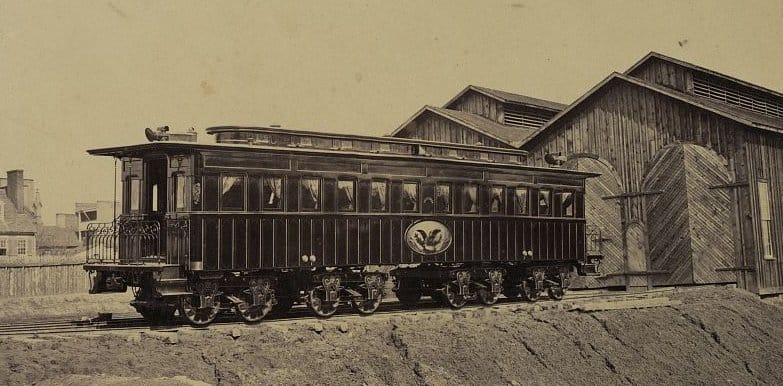Abraham Lincoln’s Funeral Car

For the past fifteen years, I’ve often heard from researchers and TV documentarians who want to know something about the railroad car in which Abraham Lincoln’s body traveled to its final resting place following his assassination in 1865. These people find me because I wrote an article about the car during the 1990s. Apparently too little has been published about it. (I included my essay in my book Lost Minnesota: Stories of Vanished Places, whose Amazon link you’ll find to the right of this blog.) Sadly the car, which was called the United States, suffered a fate almost as tragic as the President’s.
Designed and constructed at the U.S. Military Car Shops in Alexandria, Virginia, in 1863 and 1864, the special car, built to transport a living Lincoln and his cabinet, was one of the most elaborately appointed railroad vehicles ever made. It had upholstered walls, etched-glass windows, 16 wheels (adaptable to both standard and five-foot-gauge tracks) to ensure a smooth ride, and rooms for working and relaxation. The exterior sides bore a large painted crest of the United States.
Perhaps thinking the United States too ostentatious, Lincoln did not use it. After his death, however, the car carried Lincoln’s body on a two-week, 1,662-mile journey from Washington, D.C. to Springfield, Illinois, for burial. The train stopped in many cities on the way — meeting huge crowds along the tracks — and the President’s casket was removed each time for display and public mourning.
Later, the military sold the United States to the Union Pacific Railroad for $6,850. It spent eight years as an executive car. Then, for $3,000, it went to the Colorado Central Railroad, which stripped it (leaving only the wall upholstery), installed wooden benches, and put it into service as a day coach and later as a common work car.
Thomas Lowry, president of the Twin City Rapid Transit Company, lamented this fate for what he called “the most sacred relic in the United States.” He bought and restored the car in 1905, hoping to donate the United States to an organization that would house and preserve it. After his death the car passed to the Minnesota Federation of Women’s Clubs.
On March 18, 1911, just months before the Federation planned to move the car to a permanent exhibition space, a grass fire swept the area of Columbia Heights, Minnesota, where the United States was sitting idle. The car burned completely. Historians salvaged only a coupling link from the ashes. Had the railcar survived, it surely would be a popular destination for the countless people today interested in Lincoln and the Civil War Era.